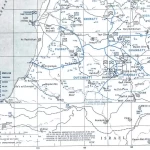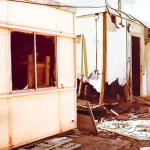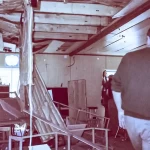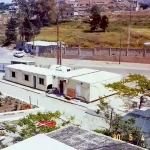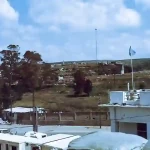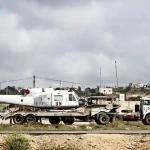By PRO IUNVA
When the United Nations Interim Force in Lebanon was being established in Mar 1978, the Force HQ was set up in Naqoura as a “temporary” HQ, some UN documents refer to it as a Tactical HQ. The military advice at the time was to locate the HQ in the Lebanese Armed Forces barracks in Tyre. This was not politically possible as the Tyre Pocket was excluded from the Area of Operations. Naqoura was 4 Km from the Armistice Demarcations Line (ADL) between Israel and Lebanon at Rosh Haniqra and well within the Enclave. This meant that the HQ was isolated from the battalions and vulnerable with its back to the Mediterranean and overlooked by high ground with just one road, the coastal road running from the ADL through Sidon, Beirut to the north. The Lebanese government insisted that the FHQ remain in Naqoura because they feared that Israel might annex the border strip of the Enclave.
During 1979 and 1980, UNIFL HQ was attacked three times by the Forces (DFF). The first attack was on 29 Mar 1979 in which one member of FrenchLogsBn was killed and two were wounded. The second attack was on 18-19 Apr 1979 in which six Irish personnel from No 2 HQ Coy Camp Command two Dutch Capts were wounded.The 1979 attacks were mounted by Maj Saad Haddad in response to the proposed deployment of a Bn of the Lebanese Armed Forces in the UNIFIL AO – the move was in accordance with a UN Security Council calling for the Lebanese government to re-establish its authority in south Lebanon. From 11 Apr, the DFF increased their forces in the area of Naqoura and on 13 Apr, they cut off all road traffic to and from UNIFIL HQ. On the morning of 18 Apr, a Norwegian helicopter was fired on and damaged as it landed. Shortly afterwards, three DFF men started to lay a cable on the road in the direction of NorAir. An Irish sentry challenged them and there was a firefight between the DFF and personnel from the Dutch contingent, one DFF man was killed and the other two were detained. Soon after, they were released and allowed carry away their dead comrade. Sporadic grenade, small arms and mortar fire was directed by the DFF from around 1000 hours for the remainder of the day. After a lull in firing, the all clear was announced. At 0015 on 19 Apr, MG and mortar fire was directed at prefabricated accommodation huts and the six Irish personnel were wounded. The eight wounded were treated at the Norwegian Medical Company field hospital (NorMedCoy), one of the Irish casualties underwent surgery for stomach wounds, another for very serious shrapnel and bullet wounds to both legs.
Haddad declared the Enclave as “the State of Free Lebanon” on 18 Apr 1979.
In Apr 1980 UNIFIL personnel in Naqoura consisted of FrenchLogsBn with 524 personnel, French Engr Pl with around 26 personnel, ItalAir (Heliciopter Wing) with 33 personnel, NorMedCoy with approximately 95 personnel, UNIFIL HQ Camp Comd made up of a GhanaianDef Pl of 57 and 47 personnel from 1IrComp (Irish Component). In addition, Irish officers and NCOs were employed in Ops Branch, Logs Branch, Mil Pers Branch, Humanitarian Branch, Mil Info Branch, Engr Branch; theWelfare Officer, the Force Engr and the Force Sigs Officers were Irish.
At 1550 hours on Saturday 12 Apr 1980 telephone lines from UNIFIL HQ at Naqoura were cut. Ten minutes later, small arms fire started to strike the Operations building and firing quickly spread to the main compound, to buildings housing the contingent guard, the French Engr Pl, the ItalAir compound and the NorMedCoy field hospital and quarters.
Between 1823 and 2038, a total of eighty five rounds of artillery, mortar and tank fire impacted within the UNIFIL HQ area, Italair and NorMedCoy compounds, some of the munitions were phosphorous rounds. The firing came from DFF position on the coast road north of Naqoura and from the high ground around the village of Naqoura.
Firing ceased at 2040 hours after UNIFIL informed the IDF that, unless the firing stopped, UNIFIL would return fire against known DFF and IDF positions. The FC and UNTSO COS contacted IDF HQ in Jerusalem and the US Ambassador who spoke with the Israeli Prime Minister.The cessation of fire coincided with the arrival of MajGen Ben-Gal, OC IDF Northern Comd, at RosHaniqra, the crossing point on the ADL between Lebanon and Israel. At 2216 hours a meeting was held in Naqoura between Gen Emmanuel Erskine, UNIFIL FC, Gen Ben Gal IDF and Maj Saad Haddad DFF, this was an inconclusive meeting.
During the firing, one UNIFIL officer, Lt Col DeLaforge (France) a staff officer in Logs Branch suffered splinter wounds to his forehead. He was carried to a place of safety by an Irish officer, Capt Paddy Gore.
The following damage resulted from the attack:
The Italair fleet of four Agusta Bell AB205helicopters were seriously damaged and rendered unserviceable by mortar and small arms.
The maintenance hangar was partially damaged; eighty per cent of helicopter spare part was destroyed.
Ten vehicles were damaged by shrapnel.
Two long range radio sets and other comms equipment were damaged by artillery and mortar fire.
The plumbing, emergency power and electrical systems were seriously damaged.
Of the twenty one prefabricated buildings that were hit, fifteen were completelydestroyed. Three concrete buildings were partially damaged by mortar and artillery fire. The Camp Comdt’s office, the orderly room, logistics stores and the PX were damaged.
Serious damage was caused to reserve supplies, refrigerators, clothing, bedding and personal equipment.
From the afternoon, Irish personnel and members of the MP Coy took up defence of the HQ Compound and Tara Camp while the French Logs Bn secured their own area. The NorMedCoy Defence Pl secured their area and the adjacent ItalAir compound.
From Sunday 13 Apr 1980, the 47 personnel of 1 Irish Component were engaged in reinforcing shelters, sandbagging details and general security of the HQ while, at the same time trying to prepare for handover. During this time, the DFF fired sporadically and much of the work had to be done under the cover of darkness.
The rotation flights were scheduled for 23 Apr, 1 May and 7 May. 1 IrComp personnel for Chalk 1 and Chark 2 had to travel by road to Beirut via Israel, the Golan Heights and Damascus on the days before rotations and to overnight at UNIFIL House in Beirut. Chalk 3 had to travel by air on the one ItalAir helicopter that was repaired and airworthy to the Fijian Bn AO and to travel by road to Beirut. The incoming 2 IrComp and UNIFIL HQ staff also had to travel to Naqoura by the same routes and this made for difficult handovers.
Photo credits George Kerton

